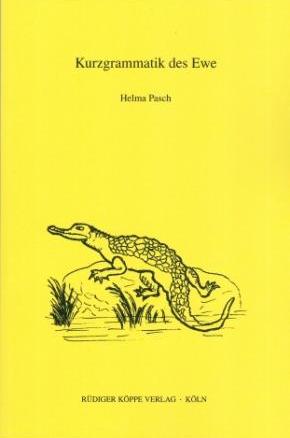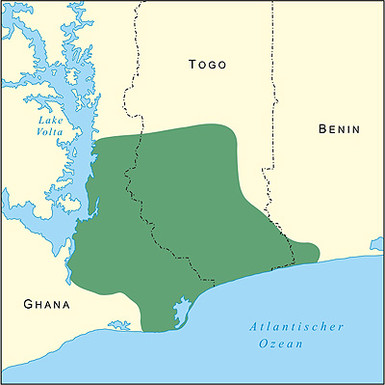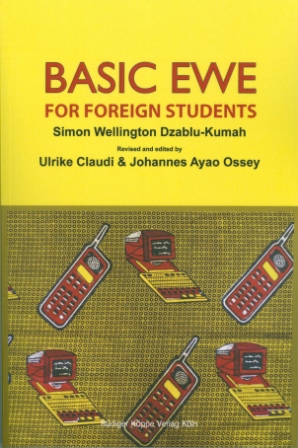


Kurzgrammatik des Ewe
Author: Helma Pasch. Series edited by: Wilhelm J.G. Möhlig †, Bernd Heine.
Series: GA Grammatical Analyses of African Languages Volume 5
199594 pp.
numerous tables and charts, appendix: map of Ewe dialects in Ghana, Togo and Benin, author and subject index
Text language(s): German
Format: 160 x 240 mm
200 g
Paperback
€ 29.80
Buy 'Kurzgrammatik des Ewe' as a downloadable PDF document directly from our online shop »
Order 'Kurzgrammatik des Ewe' as print edition »
Ewe is spoken in the West African countries Togo, Ghana, Benin and Nigeria and is one of the best documented African languages – since the works of Diedrich Westermann (1875–1956). This grammatical sketch represents an introduction to the phonology, tonology, morphology, and syntax of Ewe.
Special focus lies on a partly new description and examination of the conventional tonology. The description of the language is based on the Aŋlo-dialect which is acknowledged in Ghana and Togo as standard language. It also takes into account the form and structure of dialects that are spoken in other regions towards the East. This volume contains a map of dialects of Ewe as well as an author and subject index.
In 2013, an introduction into Ewe for pedagogical purposes was published by us that already in 2015 appeared in a second, fully revised edition, furthermore a study of animal names among the Ewe (see the links below):
Accompanying material:
- A Linguistic Study of Ewe Animal Names among the Ewe of Ghana
(ISBN 978-3-89645-474-4 ) - Basic Ewe for Foreign Students
(ISBN 978-3-89645-584-0 ) - Studies in Ghanaian Languages and Linguistics
(ISBN 978-3-89645-366-2 )
Cross-reference:
- Die Konstruktion von Ethnizität
(ISBN 978-3-89645-207-8 ) - Hexenjagd und Aufklärung in Ghana
(ISBN 978-3-89645-909-1 ) - Verwandtschaft und Mittelklasse in Ghana
(ISBN 978-3-89645-844-5 ) - Voices of Affliction
(ISBN 978-3-89645-245-0 )
Reviews
Any grammar of a Gbe language is sure to be of interest not only to specialists in Ewe, Fon, and so on, but also to typologists, to native speakers of the languages in question, and to another audience not often taken into consideration by Africanists, namely the growing number of creolists, who are especially keen on finding structural parallels between Gbe languages (which we know to have been important in the speech economy of slaves in the earlier stages of the formation of several creoles, including Saramaccan in Surinam and Mauritian Creole French). These factors should guarantee that the book serves a relatively wide readership. As Pasch (P) herself points out (9) Ewe is one of the best-described languages in Africa, not least by germanophone [sic] scholars such as Diedrich Westermann and, in our own time, Thilo Schadeberg, and she adds to this body of description with a short taxonomic grammar based largely on fieldwork with native speakers working in Cologne. [...]
Given that Ewe is so well described, and given that opportunities for blazing a trail in Gbe linguistics are so limited (on page 9 P deplores the fact that it is not possible in the state of current scholarship to write a pandialectal or comparative grammar of Gbe languages), P does an admirable job in presenting the main and many of the minor features of the language. Every example is tone-marked (a usage which, amazingly, is still by no means standard in books dealing with African languages) and glossed both with a literal translation and a more free-flowing “grammatical” German equivalent. Examples are drawn from a number of Ewe dialects, and the provenience of these is always indicated. Naturally, as one would expect from such a skilled Africanist as P, the language is analysed in terms of its own structural categories, and the coverage is weighted accordingly, so that the discussion of “adjectives”, a category which exists in Ewe but which has few representatives there, takes up little more than a page (67-8), while as much space (26-7) is spent on the more typically African category of ideophones, and fourteen pages (47-60) are devoted to what in Ewe is a much more important structural phenomenon, verb serialisation-a topic which is especially dear to the hearts of the creolists mentioned above.
A preface with acknowledgments, a table of contents, and a preface introduce the work (5-9). Discussion of Ewe structural phenomena takes up 76 pages (10-85); a one-page map, a bibliography, and an exhaustive index complete the work. [...]
The coverage of Ewe in this book is, with the exceptions noted, remarkably full, given the concision of the work overall. I would maintain, however, that there is something of an argument in favor of making such brief works maximally useful by anticipating the needs and wants of the potential audience on the basis of what it is known that descriptive linguists looking for a one-stop reference point on the basics of such a book might want. Two or three sample texts, which would have allowed one to look more closely at matters of paragraph structure and discourse, would have been extremely welcome, while as an enthusiast for the study of the lexicon in natural languages, I would have welcomed the provision of a translation into Ewe of a diagnostic vocabulary, for instance the Greenberg 547-item wordlist as widely used in Africa. But nevertheless what we have here, though by no means the final word, is a good and reliable introduction to a historically and regionally important West African language.
Anthony P. Grant in WORD, 51/3, 2000, 422-423
| « back | Print version | [top] |
 Books
Books Audio
Audio Biographies
Biographies Series
Series Festschrifts
Festschrifts Journals
Journals